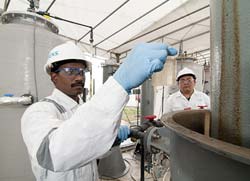Water purification unit generates its own energy

The pilot facility for this process, which is located at a site run by Singapore’s Public Utilities Board, has been operating in an energy- neutral manner since June 2010. Now, the city state is building a much larger pilot facility – one that will process 300 times more effluent than its predecessor, or about as much sewage water as is produced by around 1,000 people.
A typical urban biological water purification facility accommodates water from 10,000 to 100,000 residents. Today an aerobic (ventilated) process is used in which bacteria break down impurities in water by digesting them and converting them into new bacterial substances.
This produced bacteria flakes filled with impurities — forming sludge that is then separated and either deposited in landfills or burned. But the organic impurities contain ten times more energy than needed to do the cleaning itself. They can therefore be used to generate methane, which could be used in gas-fired power plants or combined heat-and-power plants. However, sludge concentrations in municipal sewage systems are too low to produce methane economically.
With this in mind, development engineers from Siemens Water Technologies have developed a technology for charging bacteria flakes with organic impurities for an extremely short time during ventilation. As a result, bacterial reproduction is minimized. After most of the water is separated, the bacteria ferment the impurities into methane in an anaerobic process step. After two aerobic steps and one anaerobic step, the sludge has been broken down so that the least possible amount of sludge remains and the largest possible amount of methane is available, as reported in the latest issue of the research magazine “Pictures of the Future”.
The pilot facility now in operation cleans around half a cubic meter of wastewater per day. A conventional water treatment plant requires a little less than 0.25 kilowatt-hours of energy to do this, so the pilot unit needs to generate roughly that amount of energy in the form of methane. A bigger facility could be run in an energy- neutral manner. Market launch of the technology is scheduled for 2012.
Media Contact
More Information:
http://www.siemens.com/researchnewsAll latest news from the category: Power and Electrical Engineering
This topic covers issues related to energy generation, conversion, transportation and consumption and how the industry is addressing the challenge of energy efficiency in general.
innovations-report provides in-depth and informative reports and articles on subjects ranging from wind energy, fuel cell technology, solar energy, geothermal energy, petroleum, gas, nuclear engineering, alternative energy and energy efficiency to fusion, hydrogen and superconductor technologies.
Newest articles

Recovering phosphorus from sewage sludge ash
Chemical and heat treatment of sewage sludge can recover phosphorus in a process that could help address the problem of diminishing supplies of phosphorus ores. Valuable supplies of phosphorus could…

Efficient, sustainable and cost-effective hybrid energy storage system for modern power grids
EU project HyFlow: Over three years of research, the consortium of the EU project HyFlow has successfully developed a highly efficient, sustainable, and cost-effective hybrid energy storage system (HESS) that…

After 25 years, researchers uncover genetic cause of rare neurological disease
Some families call it a trial of faith. Others just call it a curse. The progressive neurological disease known as spinocerebellar ataxia 4 (SCA4) is a rare condition, but its…





















